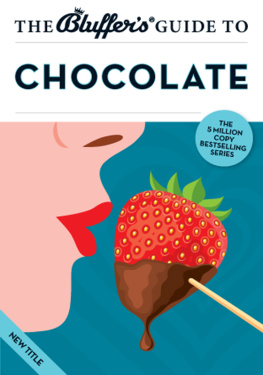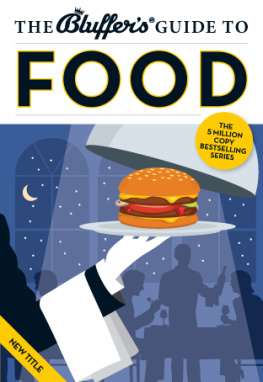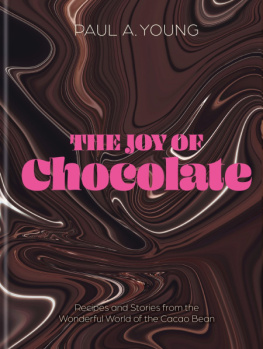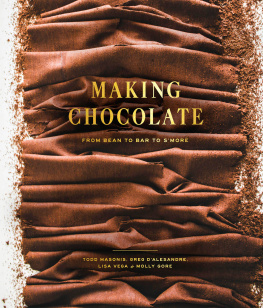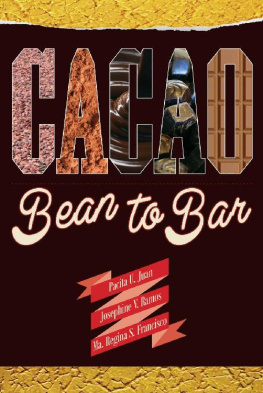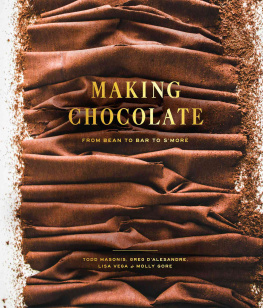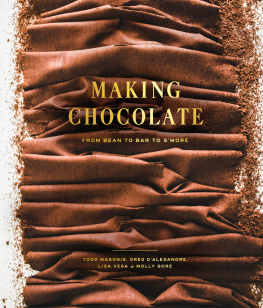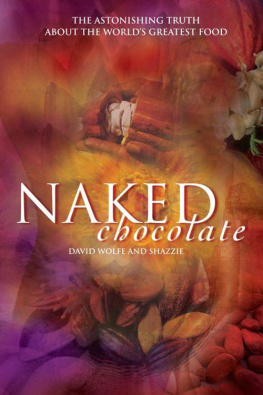

Hammersley House
5-8 Warwick Street
London W1B 5LX
United Kingdom
Email:
Website: bluffers.com
Twitter:
Published 2014
Copyright Bluffers 2014
Publisher: Thomas Drewry
Publishing Director: Brooke McDonald
Series Editor: David Allsop
Design and Illustration: Jim Shannon
All rights reserved. No part of this publication may be reproduced, stored in a retrieval system or transmitted in any form or by any means, electronic, mechanical, photocopying, recording or otherwise, without the prior permission of Bluffers.
A CIP Catalogue record for this book is available from the British Library.
Bluffers Guide, Bluffers and Bluff Your Way are registered trademarks.
| ISBN: | 978-1-909937-04-8 (print)
978-1-909937-05-5 (ePub)
978-1-909937-06-2 |

If theres one food item that can really lay claim to being the food of love, its chocolate.

THE FOOD OF LOVE
S hakespeare once suggested that music was the food of love. These days, chocolate has a powerful claim to being the food of love not to mention the new black, the new Friday, the new 50, the new 80 and the new rock n roll as well.
It all started with the sexing up of food itself. A few years ago, you were a genius if you could mix up a prawn cocktail sauce and translate half a dozen items on a French menu. These days, even if you own only a kettle and a toaster, many people still expect you to be able to rustle up something to make Gordon Ramsay weep, be fluent in 14 different menu languages and be able to spot a ripe avocado at 20 paces.
A rudimentary knowledge of food is no longer socially acceptable. People do not simply ask you where you went on holiday; they want to know what and where you ate when you went on holiday, mostly so that they can ask if you visited that charming little deli in the old town that weaves its own tiramisu and crochets its own olive oil. People dont want to know what youve done to the beef; they want to know the cows name, its family tree, which field it was kept in and whether it was Jethro or his brother who killed it. In the same way, they now want to know which bean has been used in the composition of your chocolate, and on which estate in which country it was grown.
There could be many reasons why this sort of knowledge is now so desirable. Perhaps it sets you apart as a world traveller with an unquenchable curiosity and a wealth of fascinating experience behind you. Maybe its just because it suggests that you have a great deal of disposable income. Whatever the reason, theres one undeniable fact: it makes chocolate a wonderful subject for the art of bluffing.
So to return to the Shakespeare paraphrasing, if theres one particular food item that can really lay claim to being the food of love, its definitely chocolate. Its cool, its sexy, and its available in myriad forms everywhere, from service stations to dedicated temples to the chocolatiers shop. It can be accessible or luxurious, cheap or expensive. Its produced all over the world and has a wealth of history behind it. It is said to possess all sorts of qualities, from aphrodisiac to energy booster. The process to turn it from bean to bar is fantastically complex. It is, therefore, the perfect food for the bluffer.
Over the next 100 pages or so youll find everything you need to know to impress friends, family, colleagues, the opposite sex, passing chefs and patronising waiters. Whether youre a regular consumer of French luxury
chocolate Valrhona or if your knowledge begins and ends with a Mars Bar, youll be able to hold your own in any chocolate-related situation. Even better, should you wish (for whatever reason) to do the additional research required without eating lots of different chocolate, this book will allow you to pontificate expertly without a crumb of the stuff passing your lips.
It sets out to conduct you through the main danger zones encountered in discussions about chocolate, and to equip you with a vocabulary and evasive technique that will minimise the risk of being rumbled as a bluffer. It will give you a few easy-to-learn hints and methods designed to ensure that you will be accepted as a chocolate aficionado of rare ability and experience.
But it will do more. It will provide you with the tools to impress legions of marvelling listeners with your knowledge and insight without anyone discovering that, before reading it, you didnt know the difference between a bar of Fruit and Nut and an artisan micro-batch production of chocolate made from pure Criollo beans sourced from the Chuao plantation in Venezuelas Aragua valley. (Try to remember the latter part of that sentence, and quote it frequently its bluffing gold.)

Ten cacao beans would secure the services of someone in ahem the worlds oldest profession; it appears, then, that some people have always done anything for chocolate.

CHOCS AWAY
I ts been a long and (often literally) tortuous route from the discovery of the cocoa bean to its packaging in purple wrapper and foil and sale in petrol stations. The complexities involved in the making of chocolate will be addressed in due course, as will the way it is wrapped.
At this point, its enough to establish that were talking about a particular product that can be made from the fruit of the cacao tree, a tree indigenous to the tropical climes of Central and South America. It is exactly the same as the cocoa tree but just that simple difference in spelling and pronunciation alone establishes you as someone with a greater depth of knowledge. As for when you should use cocoa/cacao to describe the product, the words are increasingly interchangeable. If you really want to impress, you can say that some conventions dictate that the beans are called cacao, while the powder that can be made from them is cocoa; but, in most cases, feel free to use either.
Leave the chocolate-making process until later and lets start at the very beginning. The journey thus begins some 4,000 years ago with the Olmecs, the first major civilisation in what would later become Mexico.
It is perhaps worth pointing out here that, as with so much ancient history, there are contradictory dates and stories. For many, that would be frustrating. For the bluffer, though, such vagueness is manna from heaven. Even if you have a particularly vociferous expert desperately looking for the flaws in your story, you can laugh off their allegations with practised nonchalance and a well-placed Well, yes, according to some sources or I think the jurys still out on that one.
THE OLMECS
According to some evidence, the Olmecs may have been the first civilisation in the Western Hemisphere to develop a system of writing. Theyre also said to have been the first to invent zero, calendars, bloodletting and human sacrifice; think of them as accountants gone bad. More importantly, theyre thought to be the first known people to consume cacao beans, in around 600BC. The Aztecs and Mayans may have had chocolate bars named after them, but they came later. The Olmecs should probably have a word with their legal team about that.
Next page
